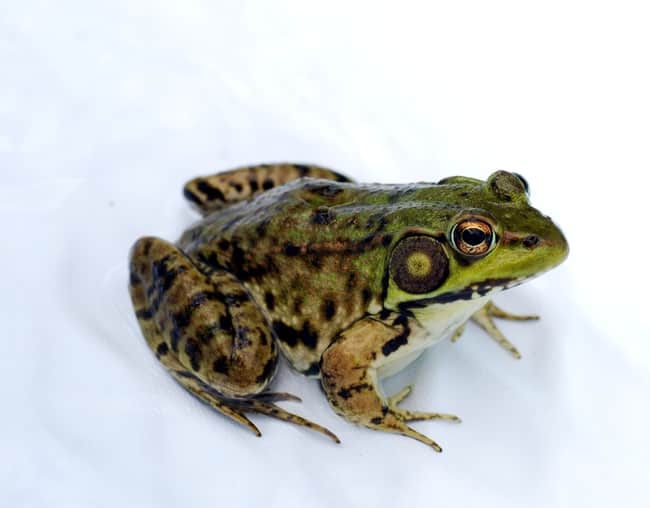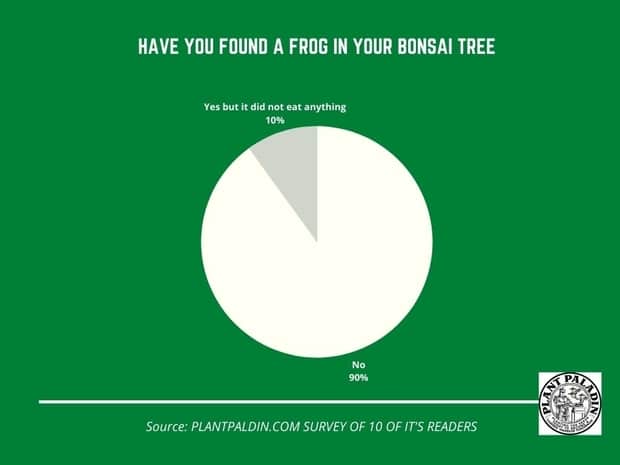This website is supported by its readers. If you click one of my links I may earn a commission. I am also a participant in the Amazon affiliates program and I will also earn a commission from qualified purchases.

So recently, my backyard has gotten a little overgrown. This attracts all manner of insects and small mammals to my garden. I’ve even spotted a few frogs. This got me thinking. As I keep my outdoor bonsai trees in my backyard, do frogs eat bonsai trees?
Frogs do not eat bonsai trees. This is because they are carnivorous predators, so they will avoid eating the leaves, branches, and fruit your bonsai produces. Frogs may, however, rest in your tree to avoid sunlight or to hide from predators.
So what exactly is the relationship between frogs and bonsai trees? And are bonsai trees dangerous to frogs? Keep reading to find out more.
Just a quick heads up, over the past three years of running Plantpaladin, hundreds of people have asked for product recommendations. As such, You can find my favorite indoor bonsai tree here (link takes you to Bonsaiboy), my favorite outdoor bonsai tree (link takes you to Bonsaiboy), or have a look at all the products I recommend here.
Do frogs eat bonsai trees?
Whilst most of us bonsai owners have to be careful, protecting our bonsai trees from insects such as aphids, whiteflies, spider mites and scale, birds and even slugs, one animal that we hear about a lot less are common frogs.
It’s not unheard of to find frogs sometimes resting in the leaves, branches, and canopy of your bonsai – especially if you have an overgrown or damp garden that attracts a lot of bugs.
So do frogs eat bonsai trees, well after researching what a few vets say, experiencing a few frogs in my bonsai trees, and even asking ten plant paladin readers I have found the following:
- Frogs do not eat bonsai trees.
- This is because frogs are carnivores when adults – meaning they will only consume other animals, mainly insects, and small mammals
- Whilst tadpoles or adolescent frogs are herbivores they are usually water-bound and so you will not find them near your bonsai.
- If you do find a frog resting or near your bonsai it can be to either hide from predators, avoid direct sunlight, or consume the insects such as whiteflies or aphids that are commonplace with bonsai keeping.
- Frogs however can carry fungal spores which can cause white spots and fungal infection in your tree if not properly cared for.
Why do frogs rest on bonsai trees?
Frogs can be found resting on bonsai trees either to avoid predators such as birds or snakes. To avoid sunlight and direct heat, and to hunt for small insects they can eat. Frogs will not eat bonsai trees, not the fruit some bonsai species produce.
Let’s explore the main reasons you find frogs in your bonsai below:
Avoid predators
Whilst frogs are predators themselves, often hunting for small insects and invertebrates to go after, common frogs found in a back yard or garden are usually middle of the food chain.
This means that they have a large number of predators such as birds, snakes, and small mammals like badgers and otters.
As such, it is not uncommon to find frogs sporadically in the dense canopy of your bonsai to avoid these predators.
Avoid sunlight
During the summer months in most climates amphibians can have a hard time.
It’s is not uncommon for frogs to dehydrate rapidly during the summer.
Without water, frogs will die in 3 to 9 days, and during particularly warm and sunny periods they may rest in your bonsai to avoid the direct heat.
Frogs might also rest on your bonsai as they know that most bonsai owners water their trees once per day meaning they can potentially get rehydrated through the process.
Should you keep sphagnum moss or other types of moss near your bonsai, these can hold up to 50 times their moisture level meaning frogs may rest in these mosses to rehydrate them too.
Eat insects
As mentioned, frogs themselves are predators too.
Typically then (and I found most commonly) frogs will tend to rest in bonsai trees to catch prey.
Now finding the odd frog in your bonsai tree is commonplace, but if you find multiple frogs or frogs resting in your bonsai throughout the year, this could be a sign that your bonsai has an insect infestation.
If this is the case, use a good insecticide or better yet a natural solution such as neem oil or mixing water with washing-up liquid to remove any excess pests.
When can you see frogs near your bonsai?
Frogs can typically be spotted in and around bonsai during the spring and summer growing season, from May to September. They hibernate during the winter months and so it will be uncommon to find frogs resting in bonsai during that period.
Frogs will also be more common in overgrown damp gardens.
Should you keep your bonsai on a bench then that has become overrun with other plants or weeds then they will be more common.
Frogs are more likely to appear after rainfall too when a lot of their prey such as slugs and worms tend to be the most visible.
Frogs are also more active at night meaning you may not see the full effects of these amphibians until the nighttime.
Can frogs damage your bonsai?
Frogs can damage bonsai trees. This is because some frogs can carry up to 100,000 fungal spores. These spores can be passed on to your tree causing a fungal infection.
Frogs also hunt insects so if you find frogs commonly in your bonsai – it can be a surefire sign your bonsai tree has an insect infestation.
How to avoid frogs in your bonsai?
Now as we can tell, more often than not having frogs near your bonsai can be problematic. Luckily there are a few tips you can follow to avoid frogs in your bonsai.
To avoid frogs in your bonsai, prune and defoliate your bonsai regularly, regularly remove insects from your tree and keep your bonsai in the brightest spot in your garden Bonsai trees can also be kept indoors for a few days to avoid any frogs.
Let’s explore these below:
Defoliate your bonsai
Defoliating your bonsai is the process of pruning and removing some or all of the leaves of your bonsai to grow back thicker leaves in the future.
One of the main reasons frogs latch onto bonsai trees is to hide from predators in their thick and dense canopies.
Removing the leaves from your tree will then limit the chances of a frog resting in your bonsai.
Remove insects from your tree
Frogs love insects and other garden pests to feed on and so it’s not uncommon to find them resting in your bonsai because of this.
To remove frogs then remove their food source.
I found the best option to do this is to blast your bonsai with water, use a neem oil spray or spray your bonsai tree with a mix of 30oz of water with one to two tablespoons of liquid soap.

Keep your bonsai in the brightest spot
Bonsai trees need a lot of sunlight, often a lot more light than other trees and plants require.
Keeping your bonsai tree in the brightest spot in your garden can cause the frogs who ret there to dry out.
This will be very uncomfortable for them and they will likely find another palace to rest if the heat and light become too much for them.
Keep your Bonsai indoors
The final option then is to simply keep your bonsai indoors.
It is incredibly unlikely that frogs are found resting indoors and so keeping your bonsai tree indoors for a few days will stop frogs from resting in them.
Are frogs beneficial to bonsai?
The major benefit of having frogs in a bonsai tree is that it can eat pests such as slugs, snails, whiteflies, aphids, and other bugs that commonly feed on and attack bonsai. Frogs then will be a natural bonsai insect repellent, remaining you can stay away from chemical fertilizers.
What frogs are the most common in bonsai?
Common frogs, common toads, wood frogs, and northern leopard frogs are the main types of amphibian species that are most commonly found in bonsai trees placed in outdoor yards or gardens.
Frogs and bonsai trees a study?
So I asked 10 plant paladin readers if they have found frogs resting or eating their bonsai trees, here were the results:

A lot of you reading this are relatively new to the art of bonsai so I would recommend checking out the following posts:
- How to find the age of a bonsai
- Bonsai repotting aftercare
- Why are bonsai pots so expensive
- Do bonsai trees smell
- Bonsai trunk fusion guide
- Are bonsai trees dog friendly?
- How to get rid of moss on a bonsai trunk
My top picks for the gear you will need!
So like I mentioned earlier, over the past three years of running PlantPaladin, hundreds of people have asked me for my recommendations on the best bonsai gear on the market.
Having spent thousands of dollars on bonsai items these past few years and tested at least 100 bonsai-specific products, I’ve listed my favorite products below – All of which I highly recommend and think you can get great value.
They can purchase directly by clicking the link to take them to Amazon.
Bonsai Tool Set: One of the significant challenges I’ve had is finding a toolset that was not only durable but didn’t break the bank. SOLIGT has recently developed a fantastic bonsai tool set that covers all the tools you need to trim, prune, and repot your trees. – You can grab it here.
Complete Bonsai Set: Many of you will want to grow your bonsai trees entirely from scratch, but finding the varicose seeds, pots, and other items in one place can be challenging. Leaves and Sole then have created a complete bonsai set that I’ve personally used that ticks all the boxes. You can grab it here.
Bonsai wire: The number of times I’ve run out of wire for my bonsai or purchased cheap bonsai wire that doesn’t do the job is embarrassing for me to admit. After a lot of trial and error, I found that using Hotop’s aluminum bonsai wire is one of the best options on the market. This can easily be used for both indoor and outdoor bonsai. You can grab it here.
This post was written by Fehed Nicass who has been passionate about bonsai for over 3 years.

